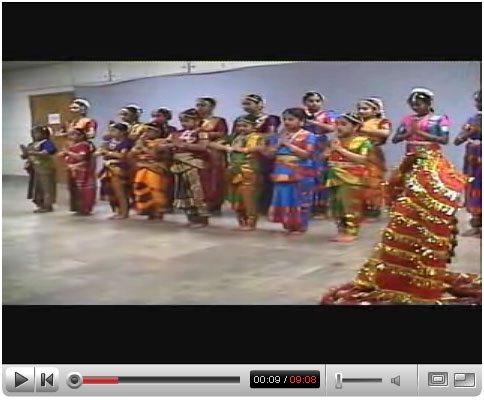Contribute
| Devotion Through Dance |
Aarthi Devarajan
01/09/2008
Click here for a video of the event.
Braving the icy aftermath of a New England snowstorm, students, parents and friends from throughout Massachusetts trekked through the slush last week for a special gathering at the Sri Lakshmi Temple in Ashland, Massachusetts. Monday, December 16, 2007 marked the commencement of the holy month of Margazhi, celebrated in Tamil Nadu and other parts of South India as a month of austerities in praise of the Divine.
In recognition of this month, the students of classical dance teachers Mrs. Jeyanthi Ghatraju (who teaches Bharata Natyam), along with Ms. Neha Parikh (who specializes in Mohini Attam), her student, Ms. Amrutha Mangalat and another youngster, Ms. Yamini Nambiar, had lovingly prepared a program of dance selections highlighting the various forms of gods and their attributes and qualities.
Bharata Natyam and Mohini Attam are two classical dance styles which date back perhaps centuries, but their contemporary forms are the product of 18th -19th century symbolic and stylistic reforms. Dance pieces are generally set to the rhythms and lyrics of Carnatic music, a classical Indian musical style which dates back to perhaps the 14-15th centuries.
The program commenced with a presentation of Bharata Natyam by the Natyanjali School of Dance, led by Mrs. Jeyanthi Ghatraju and featuring live accompaniment by an astute and well-respected group of musicians, consisting of Mrs. Bhuvana Ganesh (vocal), Dr. Suresh Mathur (flute) and 10-yr old Pranav Ghatraju on the tabla. First came a group item named “Margazhi Thingal,†where the youngest set of dancers (namely Priya Vijay, Aishwarya Sood, Meghna Iyer, Ria Sheril, Sareena Kamath, and Jahnavi Raparthi), enacted the roles of young girls in a Tamil village, preparing to dote on Lord Vishnu as part of the Margazhi festival traditions. According to custom, the month of Margazhi is meant not as a time of ostentatious celebration and gathering, but rather, a time of personal reflection and devotion. The young dancers demonstrated these characteristics of worship during Margazhi through action and gesture.
This item was followed by a verse from Thirupalliyezhuchi, performed by a mixed group of mothers and daughters (Revathi Pillai, Nisha Pillai, Poojitha Sreekanth, Medha Palnati, and Neela Natarajan). It was a treat to watch these dancers’ love of dance, which clearly creates bonds across generations!
The next piece was “Alarulu Kuriaga,†a dance item in praise of Goddess Lakshmi, the consort of Vishnu; performed by Suman Murali and Rama Kamath, Mrs. Ghatraju’s adult group of dancers. The item featured intricate jatis, or patterns of fast movement, as well as statuesque poses celebrating the goddess’ beauty and her alluring dance.
The item which followed, a Telugu folk song entitled “Brahmam okatte,†was performed by Priya Vijay and Jahnavi Raparthi. These two young dancers implored the audience through their dance to see the oneness of the divine, which recognizes the value of all living beings regardless of stature or wealth.
The final item presented by the Natyanjali School was “Dolayaam,†a piece which highlights the ten avataras of Lord Vishnu. This piece, performed by Mrs. Ghatraju’s intermediate students, Svetoslava dePaula, Khushboo Gray, Khushali Gray Neha Pillai, and Nithisha Prasad, gave the audience an example of the dramatic gestures and expressions of the Bharata Natyam style, which are used to narrate a story. Natyanjali finished their segment that evening with a mangalam on Swami Iyyappa.
Following a short break, the audience was next delighted by a presentation of Mohini Attam, a classical dance style native to the Indian state of Kerala. The performers were Ms. Neha Parikh, founder of the Nritya Kala Academy, along with Ms. Amrutha Mangalat, her student and Ms. Yamini Nambiar.
The first piece, presented by Amrutha celebrating the attributes of Lord Ganesha, and gave the audience a captivating look at the aesthetics and style of Mohini Attam, with its graceful sways and rotational movement.
Next came a dance item by Ms. Parikh, which celebrated the wonder and affection of a mother toward her child; this lilting lullaby captivated the audience with its emphasis on dramatic abhinaya, or facial expression.
The following piece, a Tillana performed by Yamini Nambiar, featured quick-paced yet chiseled movements. Youngsters in the audience were mystified by the performer’s graceful attami, or intricate neck movements, which were beautifully executed!
Finally, Neha and Amrutha presented an item entitled “Jivaâ€, which celebrates the euphoria of the worshipper when meditating upon the name of the Lord.
Reflecting upon this evening of dance, and the expressions and reactions of the audience members there, it was striking to note the comfortable and intimate atmosphere generated by the dancers and their onlookers. While some dance programs are conducted in large auditoriums, feature dazzling light effects and booming sound systems, and strive to create a detached and professional ambiance; this program was different in its intentions. The emphasis here, rather, was on the art and pleasures of learning dance, of relishing its subtleties and sharing those things with an interested and engaged audience. Here, each student was celebrated for her continued progress in the pursuit of learning dance and encouraged by onlookers and fellow dancers alike. Just as the verses of the song “Margazhi Thingal†advocate, respected teachers Jeyanthi Ghatraju and Neha Parikh truly captured the personal devotional sentiments of Margazhi by keeping the emphasis on the act of dance for the sake of dance, rather than the glitter and glam of the stage.
While there is tremendous value and pleasure to be derived from watching a dazzling performance by professional dance troupes, it was truly a magical, intimate personal experience to be a part of these young dancers’ lives, as they shared their hard work and efforts during the holy Hindu festival of Margazhi.
Arthi Devarajan is a graduate student at the Emory College focusing on religions and cultures of India and immigration history. She has learnt Bharatanatyam for several years and studies various dance forms in her research.
You may also access this article through our web-site http://www.lokvani.com/
